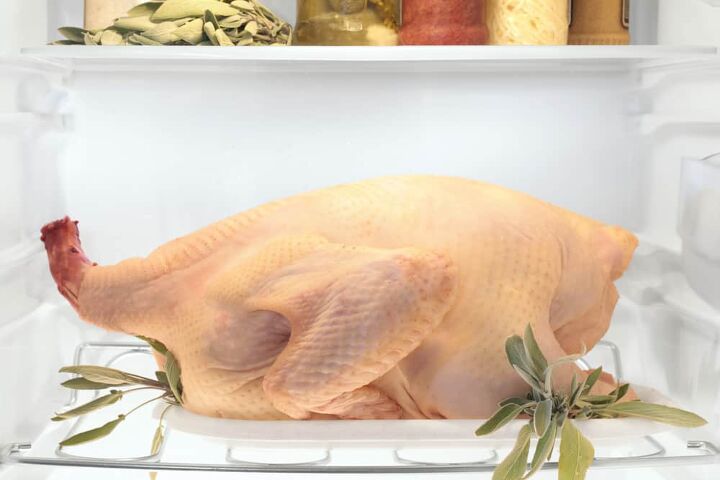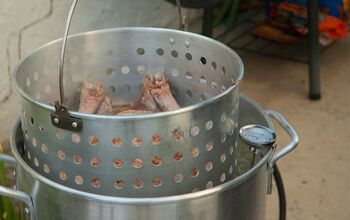How Long Can A Thawed Turkey Stay In The Fridge?

True story: my mom once destroyed the Thanksgiving turkey by leaving it to thaw in the refrigerator for a week or two. By the time we opened it, we had unleashed a major stinkbomb upon our home. It was a disaster, and that was the year we had a Thanksgiving meatloaf. Since then, I have made a point of knowing how long a thawed turkey can stay in the fridge.
You can leave a thawed turkey in the fridge for 1-2 days before it’s unsafe to eat. It is okay to put a fresh turkey in the freezer for up to 1 year until you are ready to eat it. Never consume thawed turkey that’s been in the fridge for 48 hours or longer.
Everyone knows that having a turkey gone bad can be a potential health risk due to both food poisoning and parasites. Speaking from personal experience, it can also turn your home into a foul (or fowl) mess. If you want to make sure that your turkey is going to be edible, then follow this guide.
How Long Does It Take For A Turkey To Thaw?
This is where most people mess up when it comes to their ability to keep a turkey fresh. They thaw it too long or too little, which either makes the bird unsafe to eat or too dry. This isn’t rocket science. To figure out how long you need to fridge thaw your turkey, all you need to do is look at the weight and do a little simple math.
It will take a full 24 hours of time in the fridge for every five pounds of frozen turkey you have. So, if you have a 15-pound bird that you need to thaw from a frozen-solid state, you will need to keep it in your fridge for three days. If you have a weight that’s in between the five-pound mark, just round up to the nearest five pounds.
How Can You Speed Up Thawing A Turkey?
If you’re short on time, there are still a couple of ways you can speed up your thawing process. These are some of the best options we found below:
- Cold Water Technique. Submerge the entire turkey, complete with packaging, in cold water. Change the water every 30 minutes. Keep the turkey in there with 30 minutes for every pound of meat you have. So, a four-pound turkey will take around two hours to thaw in this manner.
- Under The Tap. Place your turkey in a large pot under your sink faucet. Remove the packaging. Run the tap over the turkey on cold. Make sure that your sink can drain while the new water keeps hitting your turkey. Rotate the turkey every five minutes, until you feel the meat on the turkey “give.” It’s done thawing once ice crystals can no longer be found on the giblet bag.
- The Salt Method. Pour cool water into a large tub, and add half a cup of salt per each gallon of water. Stir. Lower the turkey into the tub, stirring to keep the water moving. The turkey will be thawed out once you can remove the giblet bag without any ice surrounding the interior.
How Long Do You Have To Cook Your Turkey Before It Goes Bad?
Once your turkey is completely thawed, you have a maximum of 48 hours before the turkey is has been fully thawed. After that, the risk of excessive bacteria growth and rot will be too much for you to safely eat your turkey. Besides, it’ll smell rank and have a strange texture to the meat.
Can You Leave A Turkey Out On The Counter Overnight?
This is not a good idea, for the most part. If you leave the turkey on the counter without cold water running over it, you will have a heightened risk of serious food poisoning. If you leave it with water running over it, you won’t. Even so, most people agree that it’s not a good idea. It’s best to be safe rather than sorry.
Why Can’t You Use Heat To Quickly Thaw A Turkey?
It is oh, so tempting to use heat from warm water, a hairdryer, or another lukewarm heat source. Don’t do it! The heat of a hairdryer or warm water is enough to make your turkey increase to the “danger zone” of temperatures between 40 and 140 degrees Fahrenheit. This range of temperatures maximizes the chance of bacteria growth.
By using warm-ish heat to thaw a turkey, you are leaving the turkey at a temperature that is conducive to bacterial growth for a time period that turns it into a risky endeavor. In other words, adding heat to a frozen turkey as a way of thawing it will increase your risk of food poisoning.
Can You Cook A Turkey That’s Still Frozen?
If you’re not in a position where you have the time to thaw out a turkey, don’t freak out. It’s totally safe (and doable) to cook a turkey even when it’s frozen. Here’s how to make sure your turkey tastes phenomenal and stays safe during cooking:
- Remove the giblet bag. Trust me when I say you don’t want to make the same mistake I did. Leaving the bag inside the turkey will destroy your dinner.
- Season your turkey as you normally would. If you can stuff it too, more power to ya. However, this is not necessary since you might not be able to fit much stuffing in. It’s up to you to decide if you want to try.
- Turn your oven to 325 degrees Fahrenheit and leave the turkey in for 50 percent longer than you typically would. This will cook the turkey and thaw it out at the same time. You might notice a little more juiciness if you use this cooking method, so it’s all good. If your turkey has a heat thermometer that pops up, you can use that to determine if it’s fully cooked.
- If your turkey is partially thawed, you can shorten the cooking times. It’s best to use a meat thermometer for this, if you have one. This will ensure that you don’t overcook your turkey but still have enough heat to keep it safe to eat
What Cooking Styles Don’t Work Well With A Frozen Turkey?
There are two main cooking styles you need to avoid if you want to stay alive during and after cooking a frozen turkey. These two cooking styles are grilling and deep-frying.
Grilling your turkey won’t work because you won’t be able to fully heat it up to the point where it’ll be safe to eat. This, in turn, will make for a terrible meal in terms of safety, flavor, and texture. Grilling should only be left to slices of turkey or for turkeys that have been fully thawed or carved.
As for deep frying? Well, this is a great way to cause a massive explosion in your backyard or kitchen. There are tons of YouTube videos showing what happens when you try to deep fry a frozen turkey. The risk is so high, the government actually had to issue a warning due to an uptick in fires resulting from frozen birds in deep fryers.
What’s The Best Way To Prepare A Frozen Turkey?
The only truly advisable way to cook a frozen turkey is to roast it. The heat from the oven will be able to properly permeate the entire frozen turkey, including the interior. Trying to grill it, frying it, or smoke it just won’t have that kind of penetration throughout the turkey’s body. When cooking your frozen turkey, use a meat thermometer and a roasting tray.
How Can You Tell If Your Turkey Has Gone Bad?
If you are concerned about your turkey being bad to eat, it’s best to assume that it’s gone off. With that said, you might notice a mild odor emitting from the bird or you might notice discoloration. You also may notice that the turkey has become slimy to the touch.
Related Question
If you want to follow food regulations, then you shouldn’t let it stay out for longer than two hours. After the two hour mark, the rate of bacteria growth will be too fast for the turkey to remain safe to eat.
What is the minimum interior temperature for a turkey to be safe to eat?Like all other poultry, it’s crucial to keep your turkey’s interior temperature at a minimum of 165 degrees Fahrenheit. This is the temperature that kills off bacteria as well as parasites like salmonella.
How far in advance can you buy a turkey?If you are the type to prepare far in advance, then frozen turkeys are going to be your new favorite food. You can buy a frozen turkey a year in advance and it will remain edible for the entire year as long as it stays frozen solid until you’re ready to cook it.
See How Long Other Foods Last In The Fridge

Ossiana Tepfenhart is an expert writer, focusing on interior design and general home tips. Writing is her life, and it's what she does best. Her interests include art and real estate investments.
More by Ossiana Tepfenhart



























